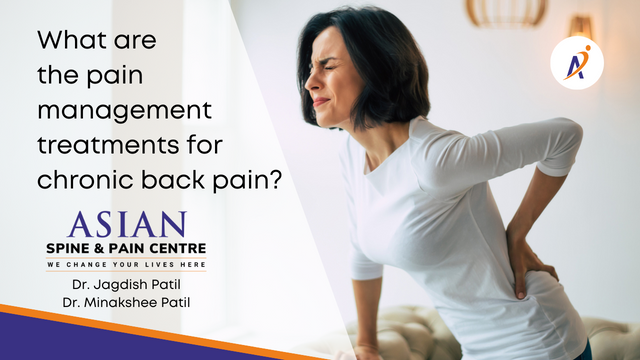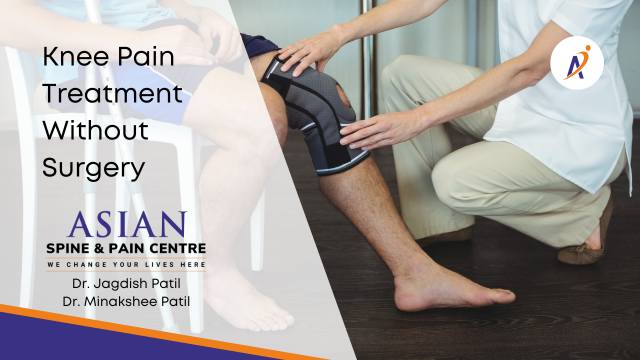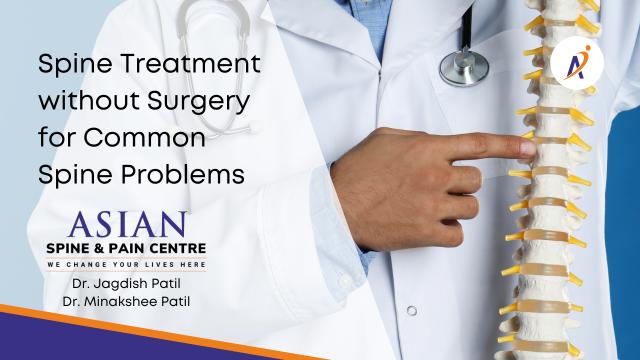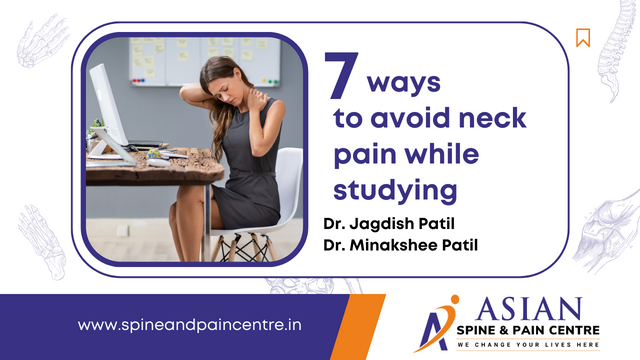Dr. Jagdish Patil & Dr. Minakshee Patil provides spine treatment without Surgery for common spine problems like spinal stenosis, herniated disc, sciatica, arthritis in Pune.

Pain, particularly persistent or chronic back pain, was once a problem that many patients commonly had to “live” with. But with recent advances in “Pain Medicine”, there are different pain management techniques which can relieve your back pain. This health blog deals with pain management treatments for chronic back pain.
Why back pain management is required?
Even though pain awareness is subjective, it should be treated for its pathological cause. Otherwise, untreated pain can interfere with the healing process by affecting the immune system and avoiding exercise & restricting mobility can further slow down the rehabilitation process. So, any chronic pain, particularly back pain has to treated at the root cause.
What is pain management?
Pain management, often known as pain medicine, is a scientific and healing arts subject that studies pain, its prevention, evaluation, diagnosis, and treatment, as well as the rehabilitation of painful illnesses.
In case of back pain, role of pain management is to diagnose and decide the need of noninvasive or invasive techniques of pain management. Requirement of surgery and rehabilitation after surgery also are part of pain management.
What are the pain management treatments for chronic back pain?
We can classify the most widely used pain management techniques in terms of the degree of intervention they involve:
- Noninvasive non-drug pain management
- Noninvasive pharmacologic pain management
- Invasive pain management
What is noninvasive non-drug pain management for chronic back pain?
Exercise – physical exertion with the aim of increasing strength, increasing flexibility, and restoring normal motion.
Manual techniques – manipulation of affected areas by applying force to the joints, muscles, and ligaments.
Behavioral modification – use of behavioral methods to optimize patient responses to back pain and painful stimuli. Cognitive therapy involves teaching the patient to alleviate back pain by means of relaxation techniques, coping techniques and other methods.
Superficial heating or cooling of skin – These pain management methods include cold packs and hot packs, ultrasound, and diathermy and should be used in conjunction with exercise.
Electrotherapy – the most commonly known form of electrotherapy is transcutaneous electrical nerve stimulation (TENS). TENS therapy attempts to reduce back pain by means of a low-voltage electric stimulation that interacts with the sensory nervous system.
What is noninvasive pharmacologic (with drugs / medications) pain management for chronic back pain?
- Analgesics – or pain medications, including acetaminophen.
- Nonsteroidal anti–inflammatory agents (NSAIDs) – includes aspirin, ibuprofen, naproxen and COX-2 inhibitors.
- Muscle relaxants – used to treat muscle spasms due to pain and protective mechanisms.
- Narcotic medications – most appropriate for acute or post-operative pain.
- Antidepressants and anticonvulsants – used to treat neuropathic (“nerve”) pain.
- Neuromodulating medications – used to treat neuropathic and muscular pain.
What is invasive pain management for chronic back pain?
- Injections or blocks – Injections provide direct delivery of steroids or anesthetic into joints, ligaments, muscles, or around nerves.
- Prolotherapy – This technique involves injection of an irritant solution to stimulate blood circulation and ligament repair at affected site.
- Radiofrequency radio-ablation – This procedure involves deadening of painful nerves via heat administered through a small needle. In carefully selected patients, this helps in approximately 60% of patients and lasts for months to years.
- Implantable opioid infusion pumps – These are surgically implanted pumps that deliver opioid agents directly to the spinal cord.
How and who decides the pain management for back pain?
As we discussed earlier there are multiple techniques involved in the pain management, so it requires multidisciplinary approach towards the pain management. At Asian Spine & Pain centre, Pune, our pain management experts, Dr. Minakshee Patil & Dr. Jagdish Patil, finalize the treatment plan after thoroughly assessing the back pain and multiple diagnostic methods to pinpoint the pathology behind the pain.
Where can you get treatment for back pain in pune?
At Asian Spine & Pain Centre, Dr. Jagdish Patil & Dr. Minakshee Patil provides multidisciplinary treatment for back pain in Pune. At our clinic, after complete evaluation of the patient with chronic back pain, noninvasive or minimally invasive pain management options are provided to the patients for long term pain free life.
Asian Spine & Pain Centre
We change your lives here!
Asian
Spine And Pain Centre
Asian Spine And Pain Centre
We change your lives here!
Dr. Jagdish Patil
M.B.B.S., M.S.(Orth), FIIPM, FIMISS
Endoscopic Spine & Joint Replacement Surgeon
Pain management Expert
Dr. Minakshee Patil
M.B.B.S., M.D., FPCI, FIPM
Interventional Pain Management Expert
Latest articles
Dr. Jagdish Patil & Dr. Minakshee Patil provides spine treatment without Surgery for common spine problems like spinal stenosis, herniated disc, sciatica, arthritis in Pune.
Follow these 7 simple steps suggested by best pain management expert, Dr. Jagdish Patil, to avoid neck pain while studying long hours.
“World Class Super Speciality Centre for Spine, Joints, Pain & Regenerative Therapies”
Let's Connect
+91-7218113113
Main Clinic
304, 3rd Floor, Choice ‘C’ Apartment, Opp. Millennium Star building, Near Ruby Hall Clinic, Pune 411001.
Send A Mail
Our facilities
Physiotherapy
Procedure Room
Pharmacy
X-ray & Imaging room
Emergency Care
Online Consultancy
FAQs:
Yes, in more than 90% cases with chronic knee pain, a noninvasive or minimal invasive procedures can be used to avoid surgeries. But in 10% cases, surgery is unavoidable and can provide long term benefit. So trust our experts at Asian Spine & pain Centre to provide accurate diagnosis and pain management treatment for your chronic knee pain.
The goal / aim of sports medicine is to maintain, sustain, and at times to regain peak physical fitness i.e., adaptability to stress, physical and mental. Main functions of sports medicine are promotive, educative, formative, recreative, competitive, therapeutic and rehabilitative in nature. At Asian Spine & Pain Centre, we provide complete care of sport sports injuries for athletes in Pune.
Yes, in most cases, physiotherapy is must to regain complete joint mobility and muscular strength. It can be required after any orthopedic treatment either surgical or non-surgical. At Asian Spine & pain Centre, we have a tea, of experienced physiotherapists to provide complete care.
You might have serious back problem or emergency for which you need immediate orthopedic care. Following signs can help you to identify these serious situations – Sharp pain rather than a dull ache, Radiating pain, Sudden weakness in the legs, incontinence, numbness or needle like pain in the groin.
Yes. X-rays are often a good tool for determining if arthritis exists and, specifically, what type. Common types of arthritis include rheumatoid arthritis, psoriatic arthritis, and osteoarthritis. Early in the disease process, more sophisticated imaging may be necessary, especially MRI. We do provide X-ray imaging services at Asian Spine & Pain Centre.
If you’re experiencing chronic pain, a doctor may recommend that you have a nerve block, a temporary or permanent procedure that disrupts specific nerve activity. It can help diagnose or treat certain types of neuropathic pain, or pain caused by nerve dysfunction or damage. At Asian Spine & pain centre, we use nerve block therapy in selected cases of chronic pain.
As is often the case, recovery time can vary from person to person depending on the location of the surgery, the type of surgery required and the lifestyle of the patient. However, most patients are able to leave the hospital the same day and are typically able to return to their active lives within 4-6 weeks after surgery. However, some are back to normal in 1-2 weeks.
You shouldn’t downhill ski or play contact sports such as football and soccer. In general, avoid sports that require jerking, twisting, pulling, or running. You should be able to do lower-impact activities, such as hiking, gardening, swimming, playing tennis, and golfing.
Arthroscopy is a procedure for diagnosing and treating joint problems. A surgeon inserts a narrow tube attached to a fiber-optic video camera through a small incision — about the size of a buttonhole. The view inside your joint is transmitted to a high-definition video monitor. Arthroscopy allows the surgeon to see inside your joint without making a large incision. Surgeons can even repair some types of joint damage during arthroscopy, with pencil-thin surgical instruments inserted through additional small incisions.



